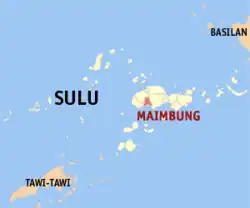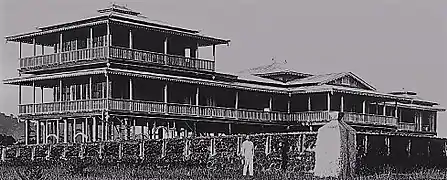Maimbung
ماءيمبوڠ | |
|---|---|
| Municipality of Maimbung | |
 Flag | |
 Map of Sulu with Maimbung highlighted | |
OpenStreetMap | |
.svg.png.webp) Maimbung Location within the Philippines | |
| Coordinates: 5°56′N 121°02′E / 5.93°N 121.03°E | |
| Country | Philippines |
| Region | Bangsamoro Autonomous Region in Muslim Mindanao |
| Province | Sulu |
| District | 1st district |
| Barangays | 27 (see Barangays) |
| Government | |
| • Type | Sangguniang Bayan |
| • Mayor | Shihla T. Hayudini |
| • Vice Mayor | Aiman T. Tan |
| • Representative | Samier A. Tan |
| • Municipal Council | Members |
| • Electorate | 35,441 voters (2022) |
| Area | |
| • Total | 77.50 km2 (29.92 sq mi) |
| Elevation | 49 m (161 ft) |
| Highest elevation | 391 m (1,283 ft) |
| Lowest elevation | 0 m (0 ft) |
| Population (2020 census)[3] | |
| • Total | 59,597 |
| • Density | 770/km2 (2,000/sq mi) |
| • Households | 10,130 |
| Economy | |
| • Income class | 5th municipal income class |
| • Poverty incidence | 71.21 |
| • Revenue | ₱ 126.6 million (2020) |
| • Assets | ₱ 321.1 million (2020) |
| • Expenditure | ₱ 94.66 million (2020) |
| • Liabilities | ₱ 166.9 million (2020) |
| Service provider | |
| • Electricity | Sulu Electric Cooperative (SULECO) |
| Time zone | UTC+8 (PST) |
| ZIP code | 7409 |
| PSGC | |
| IDD : area code | +63 (0)68 |
| Native languages | Tausug Tagalog |
Maimbung, officially the Municipality of Maimbung (Tausūg: كاومن سين ماءيمبوڠ; Tagalog: Bayan ng Maimbung), is a 5th class municipality in the province of Sulu, Philippines. According to the 2020 census, it has a population of 59,597 people.[3]
It was the seat of the Sultanate of Sulu.
History

The town hosted the Daru Jambangan (Palace of Flowers) which was the royal palace of the Sultan of Sulu since historical times. The palace was made of wood, and was destroyed in 1932 by a huge storm. Today, a few arches and posts remain from the once grand palace complex. Many members of the royal family advocated for the reconstruction of the palace, and even its enlargement, however, the government of the Philippines has yet to establish a position or a fund for the matter.
The town was officially cited by the late Sultan Jamalul Kiram III of the Sultanate of Sulu as the capital of the sultanate, and the place where he wished he was buried after death. The late sultan died in 2013 and was buried in the town afterwards. The town hosts a school named after the late sultan.
In 2016, a small replica of Daru Jambangan was built in the neighboring town of Talipao and became a centerpiece for a 'vacation park'. The replica was about 25% of the actual size of the real Daru Jambangan during its heyday. A campaign to restore the Daru Jambanagn in its original location in Maimbung is still ongoing. The National Commission for Culture and the Arts and the National Museum of the Philippines were tasked to faithfully restore or reconstruct the Daru Jambangan in Maimbung.[5]
Geography
Barangays
Maimbung is politically subdivided into 27 barangays. Each barangay consists of puroks while some have sitios.
- Anak Jati
- Bato Ugis
- Bualo Lahi
- Bualo Lipid
- Bulabog
- Duhol Kabbon
- Gulangan
- Ipil
- Kandang
- Kapok-Punggol
- Kulasi
- Labah
- Lagasan Asibih
- Lantong
- Lapa
- Laud Kulasi
- Laum Maimbung
- Lower Tambaking
- Lunggang
- Matatal
- Patao
- Poblacion (Maimbung)
- Ratag Limbon
- Tabu-Bato
- Tandu Patong
- Tubig-Samin
- Upper Tambaking
Climate
Maimbung has a consistently very warm to hot, oppressively humid, and wet tropical rainforest climate (Köppen Af).
| Climate data for Maimbung, Sulu | |||||||||||||
|---|---|---|---|---|---|---|---|---|---|---|---|---|---|
| Month | Jan | Feb | Mar | Apr | May | Jun | Jul | Aug | Sep | Oct | Nov | Dec | Year |
| Mean daily maximum °C (°F) | 27 (81) |
27 (81) |
27 (81) |
28 (82) |
28 (82) |
28 (82) |
28 (82) |
28 (82) |
28 (82) |
28 (82) |
28 (82) |
28 (82) |
28 (82) |
| Mean daily minimum °C (°F) | 27 (81) |
26 (79) |
27 (81) |
27 (81) |
28 (82) |
28 (82) |
28 (82) |
28 (82) |
28 (82) |
28 (82) |
27 (81) |
27 (81) |
27 (81) |
| Average rainfall mm (inches) | 170 (6.7) |
130 (5.1) |
125 (4.9) |
122 (4.8) |
229 (9.0) |
286 (11.3) |
254 (10.0) |
248 (9.8) |
182 (7.2) |
257 (10.1) |
233 (9.2) |
188 (7.4) |
2,424 (95.5) |
| Average rainy days | 18.3 | 15.3 | 15.2 | 14.6 | 22.8 | 24.0 | 24.3 | 23.3 | 20.5 | 22.6 | 21.9 | 19.3 | 242.1 |
| Source: Meteoblue (modeled/calculated data, not measured locally)[6] | |||||||||||||
Demographics
| Year | Pop. | ±% p.a. |
|---|---|---|
| 1903 | 1,070 | — |
| 1918 | 7,339 | +13.70% |
| 1939 | 11,228 | +2.05% |
| 1948 | 12,456 | +1.16% |
| 1960 | 14,302 | +1.16% |
| 1970 | 15,557 | +0.84% |
| 1975 | 17,166 | +1.99% |
| 1980 | 20,080 | +3.18% |
| 1990 | 17,251 | −1.51% |
| 1995 | 21,692 | +4.39% |
| 2000 | 24,982 | +3.07% |
| 2007 | 38,092 | +5.99% |
| 2010 | 28,445 | −10.08% |
| 2015 | 37,914 | +5.63% |
| 2020 | 59,597 | +9.30% |
| Source: Philippine Statistics Authority[7][8][9] | ||
Economy
The town is one of the three official ports of the province of Sulu, the other two being Jolo and Siasi. The town is also a known producer of seaweed, a major export product of the Sulu archipelago.
References
- ↑ Municipality of Maimbung | (DILG)
- ↑ "2015 Census of Population, Report No. 3 – Population, Land Area, and Population Density" (PDF). Philippine Statistics Authority. Quezon City, Philippines. August 2016. ISSN 0117-1453. Archived (PDF) from the original on May 25, 2021. Retrieved July 16, 2021.
- 1 2 Census of Population (2020). "Bangsamoro (BARMM)". Total Population by Province, City, Municipality and Barangay. Philippine Statistics Authority. Retrieved 8 July 2021.
- ↑ "PSA Releases the 2018 Municipal and City Level Poverty Estimates". Philippine Statistics Authority. 15 December 2021. Retrieved 22 January 2022.
- ↑ "Talipao, Sulu: Sleeping Like a Sultan at the Royal Palace Replica -". 12 November 2014.
- ↑ "Maimbung, Sulu : Average Temperatures and Rainfall". Meteoblue. Retrieved 31 January 2019.
- ↑ Census of Population (2015). "ARMM – Autonomous Region in Muslim Mindanao". Total Population by Province, City, Municipality and Barangay. Philippine Statistics Authority. Retrieved 20 June 2016.
- ↑ Census of Population and Housing (2010). "ARMM – Autonomous Region in Muslim Mindanao" (PDF). Total Population by Province, City, Municipality and Barangay. National Statistics Office. Retrieved 29 June 2016.
- ↑ Censuses of Population (1903–2007). "ARMM – Autonomous Region in Muslim Mindanao". Table 1. Population Enumerated in Various Censuses by Province/Highly Urbanized City: 1903 to 2007. National Statistics Office.
{{cite encyclopedia}}: CS1 maint: numeric names: authors list (link) - ↑ "Poverty incidence (PI):". Philippine Statistics Authority. Retrieved December 28, 2020.
- ↑ "Estimation of Local Poverty in the Philippines" (PDF). Philippine Statistics Authority. 29 November 2005.
- ↑ "2003 City and Municipal Level Poverty Estimates" (PDF). Philippine Statistics Authority. 23 March 2009.
- ↑ "City and Municipal Level Poverty Estimates; 2006 and 2009" (PDF). Philippine Statistics Authority. 3 August 2012.
- ↑ "2012 Municipal and City Level Poverty Estimates" (PDF). Philippine Statistics Authority. 31 May 2016.
- ↑ "Municipal and City Level Small Area Poverty Estimates; 2009, 2012 and 2015". Philippine Statistics Authority. 10 July 2019.
- ↑ "PSA Releases the 2018 Municipal and City Level Poverty Estimates". Philippine Statistics Authority. 15 December 2021. Retrieved 22 January 2022.
External links
- Maimbung Profile at PhilAtlas.com
- Philippine Standard Geographic Code
- Maimbung Profile at the DTI Cities and Municipalities Competitive Index
- Philippine Census Information
- Local Governance Performance Management System